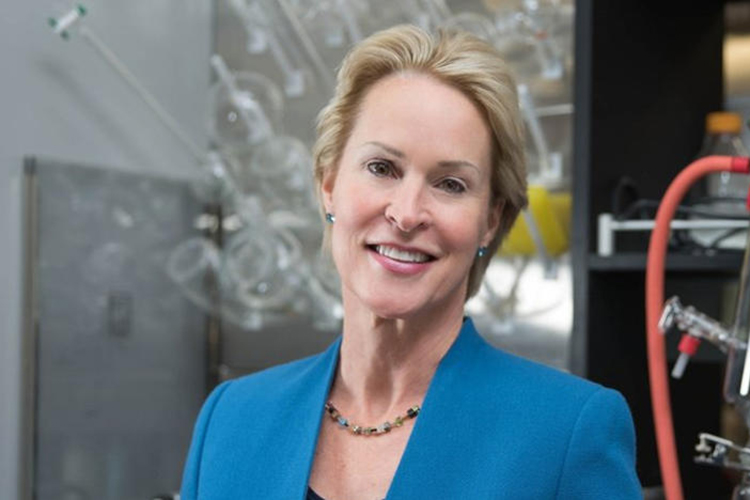Chemistry Nobel goes to UC Berkeley Ph.D. Frances Arnold
A 1985 alumna of the College of Chemistry, Arnold went on to apply the principles of evolution to the design of enzymes
October 3, 2018

Frances H. Arnold, the Linus Pauling Professor of Chemical Engineering, Bioengineering and Biochemistry at Caltech, is one of three winners of the 2018 Nobel Prize in Chemistry. (Photo by Caltech)
When Frances Arnold first came to UC Berkeley as a graduate student in 1980, she was focused on biofuels — at that time a promising new technology and, for Arnold, a way to benefit humanity by weaning society off fossil fuels.
But dropping oil prices and President Ronald Reagan destroyed that dream.
“Once oil prices had dropped, there was no future in biofuels, and Reagan basically killed all the research funding for it,” said Harvey Blanch, Arnold’s Ph.D. adviser and a professor emeritus of chemical and biomolecular engineering. “It (funding) didn’t come back again until around 2006, when oil prices went back up to over $100 a barrel.”
That setback set the stage for a new vision – using evolution to redesign enzymes for use in biotechnology – that earned Arnold the 2018 Nobel Prize in Chemistry today.
The Nobel committee split the chemistry prize, with half going to Arnold, now a professor at Caltech, “for the directed evolution of enzymes,” and half to George P. Smith and Sir Gregory P. Winter for related work on “the phage display of peptides and antibodies.” Smith is at University of Missouri, Columbia, while Winter is at the MRC Laboratory of Molecular Biology in Cambridge, United Kingdom.
“Frances’s work has added entirely new dimensions to protein chemistry and biotechnology,” said Douglas Clark, dean of the College of Chemistry at Berkeley and a friend of Arnold’s. “Frances remains at the forefront of this expanding technology and is a shining example of how exciting innovations can emerge from research at the intersection of different fields.”
After obtaining her undergraduate degree in mechanical engineering from Princeton in 1979, Arnold worked briefly in Golden, Colorado, at the Solar Energy Research Institute – now the National Renewable Energy Laboratory – before enrolling in Berkeley’s chemical engineering department to work with Blanch on biofuels. Her background in mechanical engineering meant she had to take all the undergraduate courses in chemical engineering before she could embark on her graduate program. She completed the entire curriculum in 12 months.
“Every professor in my department saw Frances as an extraordinary student because she was gifted in mathematical analysis, in expressing creative ideas and in her encyclopedic knowledge of molecular biology,” said Jeffrey Reimer, now chair of the Department of Chemical and Biomolecular Engineering.
From biofuels to biotech
Blanch was working on biofuels during a period he refers to as “Biofuels 1.0,” and after funding dropped to zero, he too moved on to other research. Arnold got involved in biotechnology, through a Berkeley group called the Center for Biotechnology Research, and ended up doing her Ph.D. work on affinity chromatography, a relatively new technique for precisely separating proteins based on their affinity for another molecule, such as an antibody. Her 1985 thesis was titled “Engineering Scale Up of Affinity Chromatography.”
She worked for about 18 months as a postdoc with the late UC Berkeley chemist Ignacio Tinoco, who researched the structure of RNA, or ribonucleic acid.
In 1986, Arnold set up her own lab at Caltech, where she initiated her work on directed evolution of enzymes, and soon was appointed an assistant professor. Her work has had a major impact in the pharmaceutical industry.
“The concept is exceedingly clever and the execution is technically elegant: combining the power of evolution with the efficiency of modern biochemical methods,” Clark said. “So-called directed evolution is now used worldwide both in industry and academia.”
“Her own work took off from a group of people doing directed evolution, but she came up with some very, very clever ways of doing it and then really took off, with applications in green chemistry and even some applications in the area of biofuels,” Blanch said. “Thanks to a whole slew of her accomplishments with evolving enzymes, she has been able to show that they can do things we never expected and have never been observed on Earth before.”
Directed evolution, Blanch explained, is based on a simple premise: that the approach taken by nature to optimize biological function, namely natural selection, can be employed in the laboratory to provide the same remarkable results.
“Arnold showed that enzymes could be ‘bred’ for behavior that may not be relevant in a natural context but is important for human uses,” he said. “Rather than having to design a process to fit an existing enzyme’s requirements, directed evolution makes it possible to fit the catalyst to the optimal manufacturing conditions.”
Arnold developed iterative methods that mimicked the random mutagenesis and selection found in nature and developed screening techniques to select mutations that addressed targeted properties.
“This technology has been particularly important for the emerging chemicals and fuels industry based on renewable resources,” he added. “Engineering microorganisms to transform sunlight or biomass into fuels and chemicals requires new biocatalysts and new metabolic pathways that do not exist in nature.”
The number of industrial enzymes that have been developed by directed evolution continues to grow, Blanch noted. In particular, Arnold has developed esterases for the pharmaceutical industry, thermophilic enzymes, enantioselective syntheses for pharmaceutical, insecticidal and herbicidal products, and enabled biocatalytic synthesis of novel natural products, such as carotenoids.
More recently she has created unusual reactions between carbon and boron, and carbon and silicon, which is “kind of fascinating because you start to think about other life forms,” Blanch said.
According to a statement from Caltech, Arnold was awakened from a “deep, deep sleep” this morning while in Dallas for a scheduled lecture today, but she immediately rescheduled to fly back to California.
“I am absolutely floored. I have to wrap my head around this. It’s not something I was expecting,” she said.